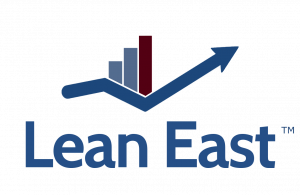Lean concepts are based on Toyota principles that originated in Japan. Lean East believes that most Lean principles are rooted in common sense, so we train companies Lean concepts without asking leaders and their employees to learn the original Japanese words. This post shares the original Japanese words for waste (muda), overburden (muri), and unevenness (mura) with our readers. In the Japanese language, it is easy to see the relationship between muda, mura, and muri. We show how these three process problems are related below.
Muda is Japanese for “Process Waste”
Muda translates to “waste” and refers to any activity that does not add value to the process that delivers the product or service for the customer. Lean focuses on eliminating muda throughout the production process. Lean East clients value stream map their process(es) and identify the eight wastes of Lean that are not valued by the customer.

Process improvement to reduce or eliminate these 8 wastes is key to having a Lean operation, and many of the organizations we work with struggle just to eliminate muda. But mura and muri complicate your process and can lead to muda themselves.
Mura is Japanese for “Process Unevenness”
Mura translates to “unevenness” and refers to inconsistencies and irregularities in production flow. Mura can be caused by factors such as uneven demand, breakdowns, or lack of materials. Lean strives to create a smooth and consistent production flow. The concept and methods of Six Sigma focus on understanding, controlling, and eliminating the causes of process variation.
Mura can be smoothed and controlled through the application of Heijunka “level loading” principles and Kanban systems. The goal is a responsive operation that responds and adapts quickly to customer demand. The kanban cards below help minimize the work in process and “even out” the operation.

Muri is Japanese for “Process Overburden”

Muri translates to “overburden” and refers to putting too much strain on people or equipment. Muri can lead to defects, safety hazards, and employee burnout.
Lean emphasizes creating a sustainable workload for both people and machines, and eliminating overburden of equipment and people is one of the main pillars of the Toyota Production System. To avoid overburden, production is evenly distributed in the Toyota assembly processes using heijunka and kanban. The work is balanced to match the Takt Time or pace of production within customer demand and the available work time.
Never forget the two pillars of Lean: Continuous Improvement and Respect for People. Minimizing overburden is a key to respecting your people!
The Relationship Between Muda, Mura, and Muri
Note how similar the Japanese words muda, mura, and muri are. These three MU concepts are related; issues with any one of the three will lead to issues with the others. For example:
- Wastes in the process often result in unevenness. For example, a quality error that takes extra time later in the process when it needs to be fixed. Or an error made in the customer scheduling process might not get noticed and result in overburden when two customers arrive for service at the exact same time!
- Unevenness often leads to moments of waiting for work followed by moments of overburden. A good example of this can be found in any store, restaurant, or walk-in health clinic. The moments of overburden often result in defects made while rushing and skipping steps. These defects create more unevenness and overburden later in the process when they need to be corrected!
- Overburden in the first place can lead to the other MUs. This could be due to a person forced to cover two roles in an operation due to an absence. Jumping from one role to the other (with gaps in between) leads to unevenness and the waste of waiting. Rushing in both roles likely causes quality defects.
The goal is to minimize all three of the MU words – muda, mura, and muri if you want to have a truly Lean operation.
Summary
We hope you found this short post full of value and containing very little muda! Please leave your comments and questions below.


Related Posts
How I am Changing the Career Advice I Give My Kids
This is Never Going to Work: Getting Lean Projects Unstuck
How to Speak so that People Want to Listen